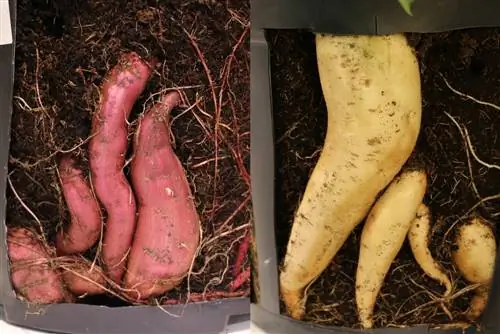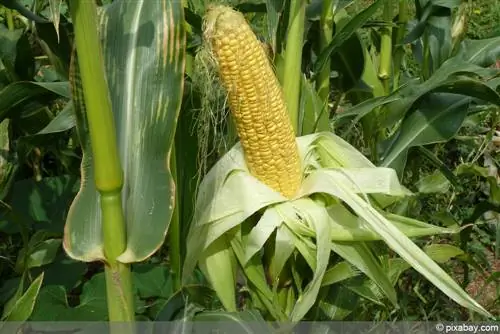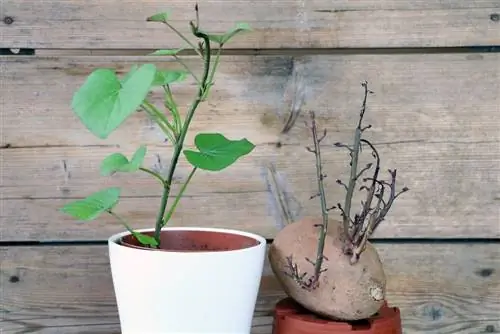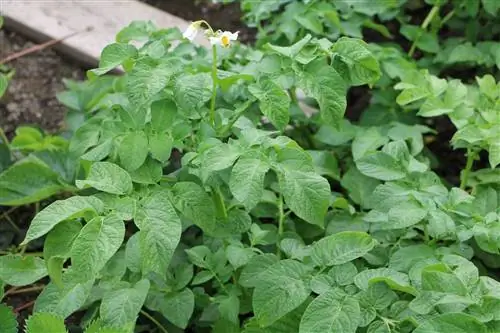- Author admin [email protected].
- Public 2023-12-17 03:39.
- Last modified 2025-01-24 12:45.
As a new star in the plant sky, the sweet potato is causing a sensation in private kitchen gardens. Although there is no botanical relationship with the potato, the root vegetable scores with a wide variety of possible uses and a magnificent flower. It tastes good boiled, fried, steamed, baked and grilled and impresses with its sweet aroma. Reason enough to include batate in the planting plan. A separate bed is not necessary for this. The following instructions show you how to grow and harvest sweet potatoes in a balcony box in a practical way.
Driving seed potatoes in substrate
Since the sweet potato is one of the morning glory plants that is not hardy, experienced hobby gardeners decide to pre-germinate the seed potatoes in early spring. In this way, batatas start the season with a head start in growth so that they can mature in time before the first frost. Seeds are available from specialist retailers or you can look for the tubers in the supermarket, where they are usually offered next to cassava at the vegetable counter. This is how pre-germination behind glass works:
- At the end of January/beginning of February, fill a wooden box with potting soil or a mix of garden soil and compost
- Insert the seed potatoes with the blunt end facing down so that the eyes are not covered with substrate
- Keep slightly moist in a partially shaded window seat at 17 to 20 degrees Celsius
The sweet potatoes will sprout within 4 to 6 weeks as long as they are watered regularly. As long as the outside temperature is below 10 degrees Celsius, the germinating roots remain in a protected environment.
Grouping sweet potatoes in water
As an alternative to growing in substrate, it can easily be done in water. This method is particularly recommended if you want to get as many shoots as possible from one or two tubers. Follow these steps:
- Halve a small sweet potato, cut large ones into thirds or quarters
- Fill a glass with water and hang a piece of tuber in it with the cut side down
- Use matches or toothpicks to stabilize the root segment in the shape of a spoke so that it does not sink in the water
- Do this with each piece individually
- Place in a bright, warm window seat until the leafy sprouts sprout
You can twist the sprouts off the tuber after 2-4 weeks. In a glass of water they will form their own roots within a short time. Specimens that do not root are discarded. To prevent rot from forming in the water, add a small piece of charcoal or add fresh water every 2 days.
Planting according to the Ice Saints
The window of opportunity for growing sweet potatoes in balcony boxes opens in May. To do this, choose a container with a volume of at least 30 liters and several openings in the bottom for water drainage. Ideally, the planter already has a pre-installed trellis or you can attach one later, as the sweet potato is a climbing plant. To plant the seed potatoes or sprouts, follow these steps:
- Put out a drainage system made of gravel, grit or pottery shards on the bottom of the vessel
- Fill the balcony box three quarters with high-quality potting soil
- Planting the germinating sweet potatoes or the individual sprouts
- At an ideal planting depth, the substrate reaches just below the first pair of leaves
- The planting distance is between 30 and 40 centimeters, depending on the variety
- Water the young plants generously

Place the balcony box in a sunny to partially shaded location where the plants cannot come under the blazing midday sun. Ideally, it is also in a location protected from the wind so that the tendrils, which can be up to 3 meters long, can develop undisturbed.
Care
In order for rich and magnificent tubers to develop, no extensive care is required. During the three-month ripening period, it depends on:
- Keep the substrate evenly moist
- Pull out any weeds immediately
- During summer droughts, water thoroughly as soon as the top layer of soil dries
- Start supplying nutrients between 4 and 6 weeks after planting
- Administer an organic liquid fertilizer in diluted concentration every 7-10 days
- In cool summer weather, spread a layer of mulch made of leaves or straw
The morning glory plant is not cut back. The shoots should also not be broken out. Parallel to growth, the tendrils are attached to the climbing aid. If the planter is on a balcony railing, the decoratively leafed and beautifully flowering tendrils hang elegantly. Withered and faded things are cleaned out from time to time to attract more flowers.
Tip:
Sweet potatoes are so vigorous that within a short time they cover an entire wall of the house with greenery or act as a privacy screen on the balcony seat.
Harvest
The long-awaited harvest time for home-grown sweet potatoes on the balcony begins in September. If the above-ground parts of the plant gradually turn yellow, this is the signal that tubers in the substrate are ready for harvest. How to harvest your sweet potatoes correctly:
- Dig up the ripe batatas one by one with your hands
- Gardening tools of any kind damage the delicate shells
- Remove all shoots from the sweet potatoes and shake off the soil
Freshly harvested, sweet potatoes do not yet have the desired aroma. The tubers only get their full flavor by being stored for 5 to 10 days at temperatures of around 30 degrees and a humidity of 80 percent. To do this, spread the harvest out in a small room and set up a heater and a humidifier. Only after this procedure do the batatas earn the name sweet potato and are prepared.
Varieties with good tuber formation
The choice of variety plays an important role in ensuring that growing sweet potatoes results in a bountiful harvest. Therefore, plant batates, which have been proven to produce numerous daughter tubers. This attribute does not characterize all breeds; sometimes more emphasis is placed on flower formation, which is usually at the expense of tuber growth. The following sweet potato varieties were thoroughly tested by the Saxon State Office for the Environment, Agriculture and Geology, whereupon they were certified as having good tuber formation:
Sweet potato 'Marguerite' (Ipomoea batatas 'Marguerite')
Its visual appearance impresses with lime-yellow heart-shaped leaves and a delicate white flower. In a sunny planter, the variety reaches a diameter of 71 centimeters with shoots up to 40 centimeters long.
- Growth height in a sunny location: 24 centimeters
- Growth height in partially shaded place: 18 centimeters
Sweet potato 'Blacky' (Ipomoea batatas 'Blacky')
The black-leaved variety sets decorative accents on the balcony, especially in combination with its delicate white flowers. In addition, 'Blacky' was able to score points with the examiners in the field trial with magnificent tubers.
- Growth height in a sunny location: 31 centimeters
- Plant diameter: 82 centimeters
Sweet Potato 'Sweet Heart Light Green'
With its light green, tapered leaves, this variety is less noticeable. It is the large sweet potatoes that make this variety so popular for growing in planters. If there is still a partially shaded spot on the balcony, 'Sweet Heart Light Green' feels more comfortable here than in full sun.
- Shoot length in partially shaded location: 64 cm
- Shoot length in sunny place: 38 cm
Sweet potato ‘Beauregard’
This variety was not subject to field testing. Nevertheless, it has made a name for itself as one of the most popular breeds among hobby gardeners. 'Beauregard' owes this to its juicy, sweet flesh and excellent yield. This morning glory plant also proves to be extremely flexible to site conditions.
- Growth height in a sunny place: 30 centimeters
- Color of the pulp: orange
Conclusion
There is great interest in growing sweet potatoes. Although the rich tubers are not botanically related to potatoes, they are similar in every respect when it comes to planting, care and harvesting. Since the South American morning glory plant also impresses with its magnificent flowers, creative hobby gardeners are considering growing it in a balcony box. To ensure a rich harvest in time before the first frost, the seed tubers are sown behind glass from the end of January. Planted in mid-May in a planter box with a volume of at least 30 liters and equipped with a climbing aid, the bulbous morning glories are content with a little organic fertilizer every 7 to 10 days and a regular supply of water. You can safely avoid cutting back the long tendrils. From the beginning of September, wilting leaves signal that the sweet potatoes are ready to harvest. With post-ripening temperatures of up to 30 degrees Celsius and high humidity, the rich tubers are ready for consumption after 5 to 10 days.






